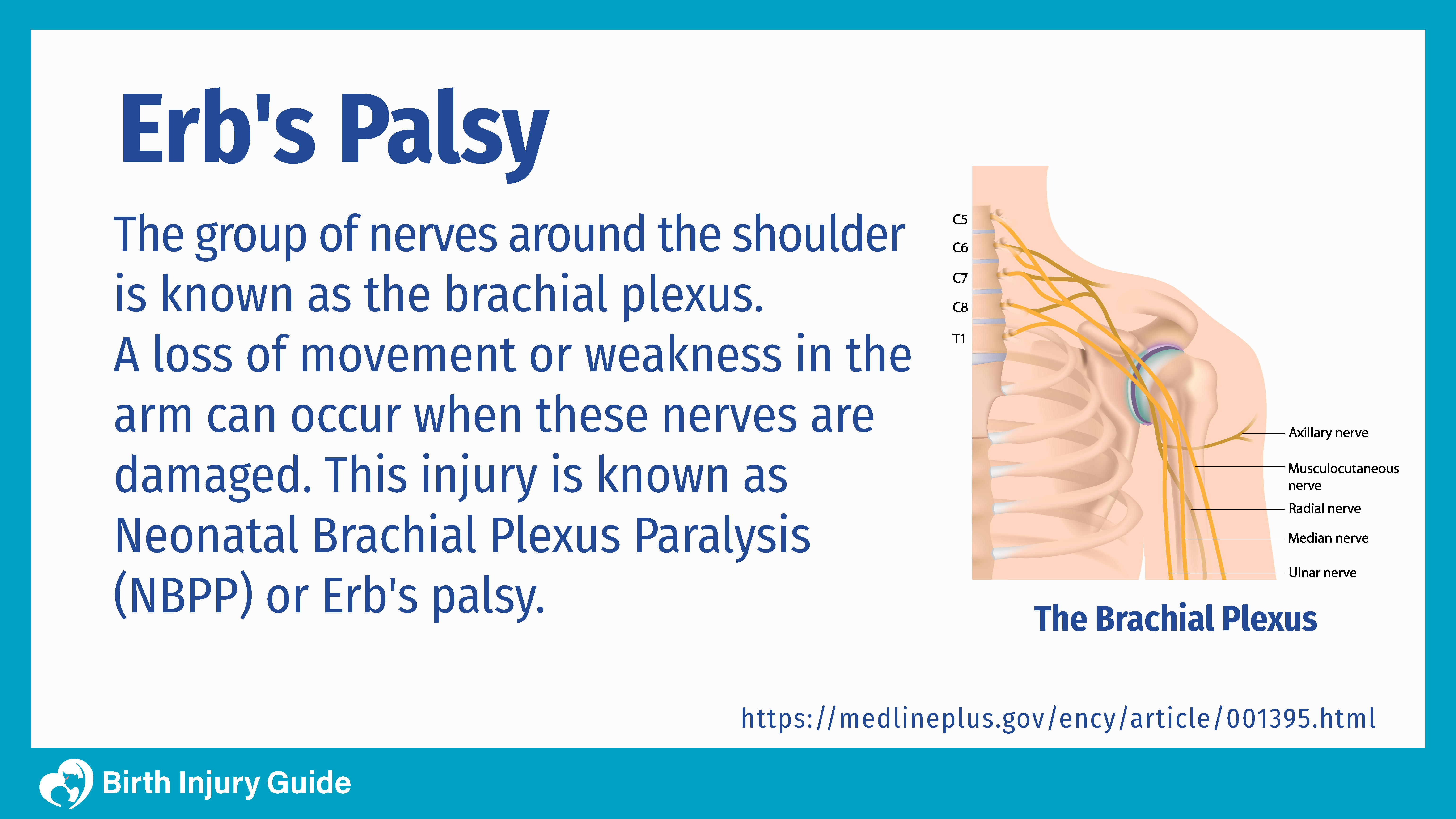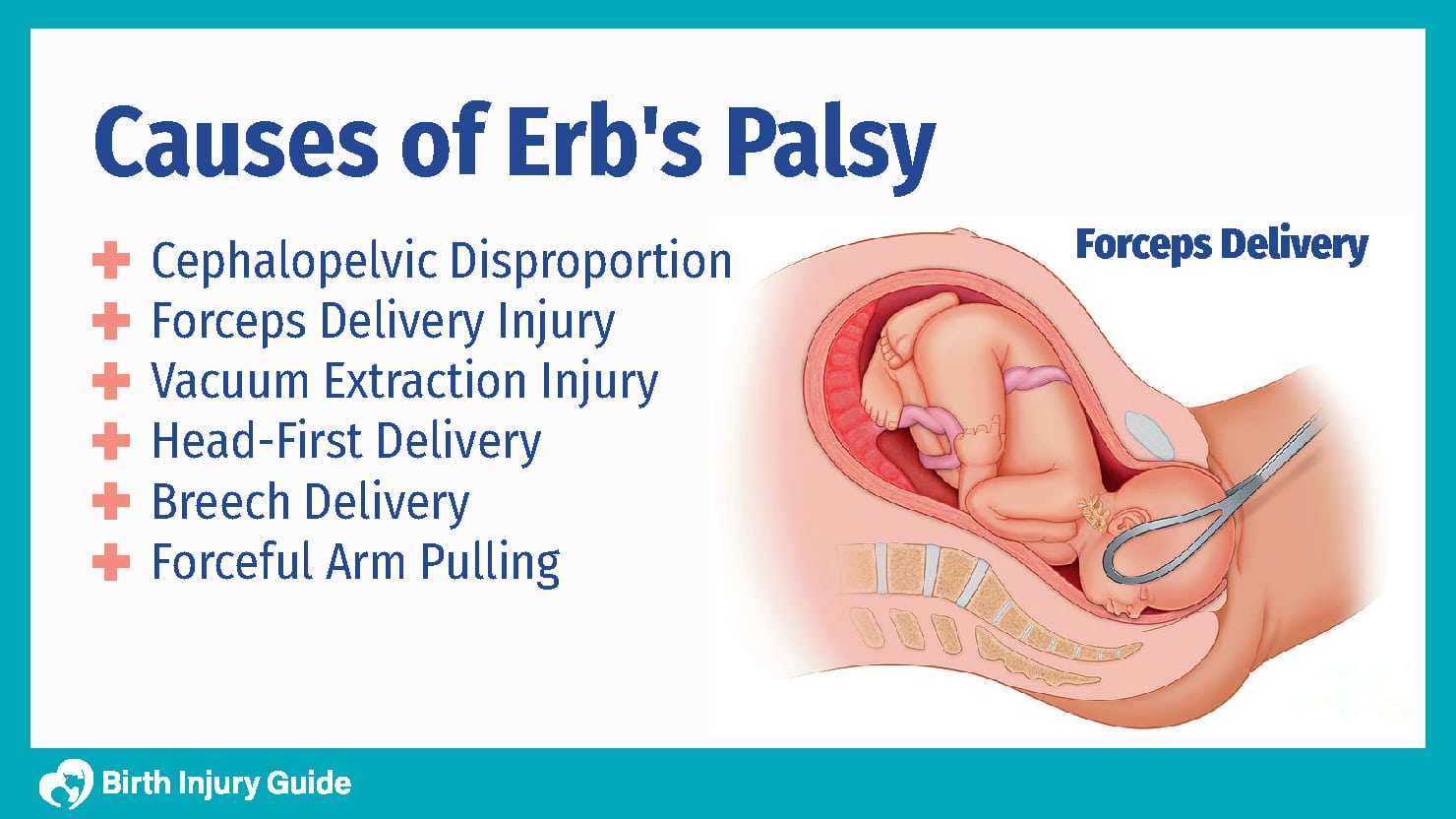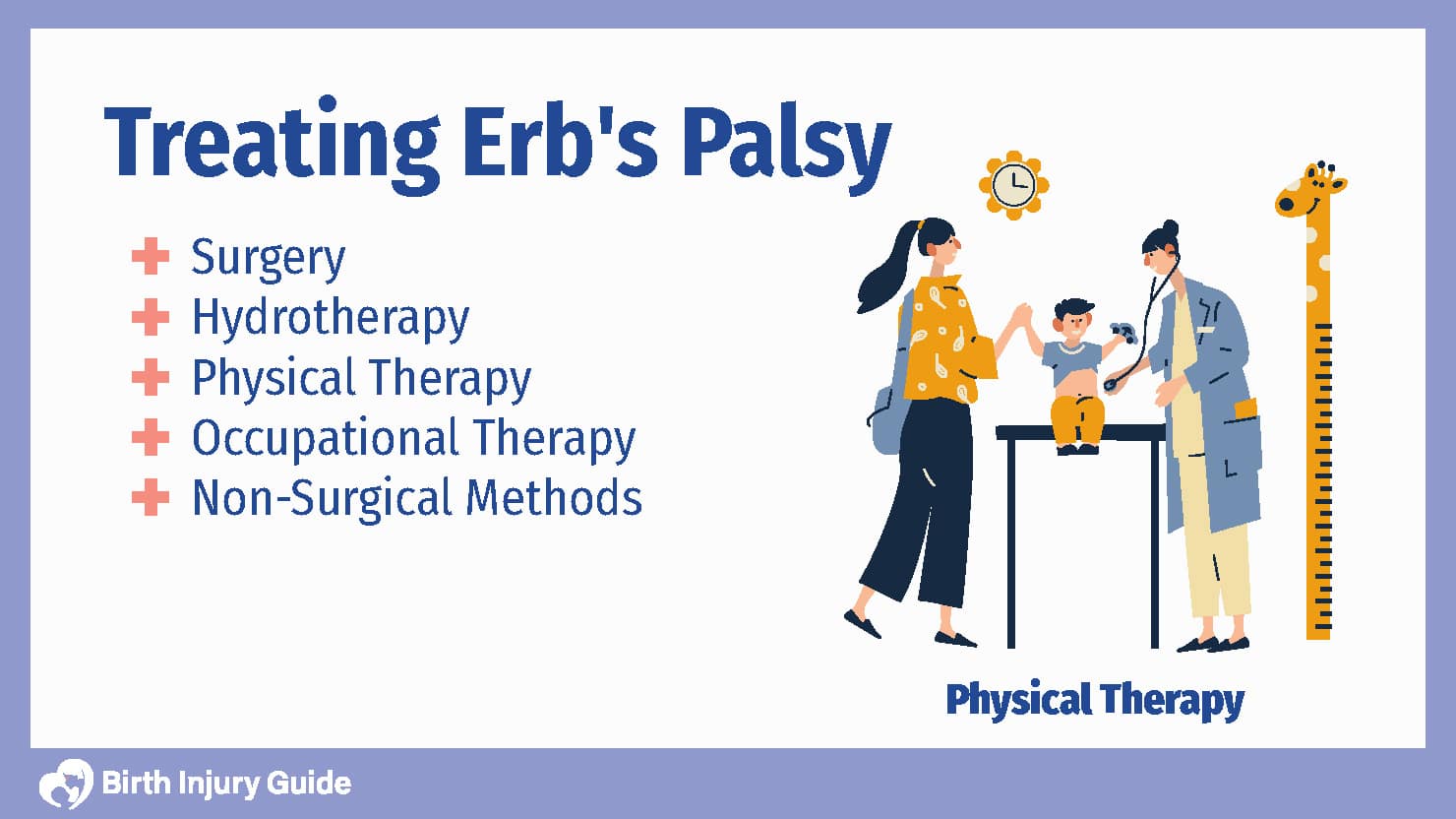
Erb’s Palsy
Erb’s palsy, a form of obstetric brachial plexus disorder, is an injury resulting from damage to a baby’s upper arm. It typically affects one or two of every 1,000 babies. The injury occurs as a result of a lesion, or injury, at Erb’s point, the area near the baby’s neck where the fifth and sixth cranial nerves merge to create the upper point of the brachial plexus network of nerves.
Sadly, many cases of Erb’s palsy are the result of medical negligence. During labor and delivery, doctors may pull too hard or improperly use forceps or vacuum extraction. Or, if labor is difficult or prolonged, the doctor may continue to attempt a vaginal delivery when a c-section would be preferable (and safer). If your child has Erb’s palsy for any of these (or other negligent) reasons, your family may qualify for compensation.
Speak with a birth injury lawyer to learn more about medical negligence, birth injuries and your legal rights.
Start Your FREE Case Review Today
If you or your child is injured as a result of medical negligence, call us to learn more.
What is Erb’s Palsy?
Erb’s palsy is an adverse condition most often resulting from a physical injury during delivery. Its negative effects can range from mild to serious, depending upon the severity of the injury. Erb’s palsy is a condition named after the doctor who first described it, Wilhelm Erb. The condition occurs when the top portion of the brachial plexus network of nerves suffers an injury. The nerves in the brachial plexus give movement and feeling to the baby’s arm, hand and fingers. Therefore, an injury to this area would affect feeling and movement.

Erb’s palsy is sometimes referred to as brachial plexus palsy because the brachial plexus nerves in the shoulder have been abnormally shifted, damaged or broken during delivery, often due to shoulder dystocia. Shoulder dystocia is when the shoulder gets stuck behind the pubic bone after the head delivers. Erb’s palsy is often the result of a difficult birth or birth trauma. If the infant is too large to make it out of the birth canal or becomes stuck against the mother’s pelvic bone, it may be necessary for the doctor to assist in delivery. Pulling on the infant’s head, twisting, or using forceps or a vacuum to assist birth can all cause Erb’s palsy.
Types of Nerve Injuries
There are four types of nerve injuries. They can all occur simultaneously and share the same symptoms of lost tactile feeling and paralysis, no matter which type of nerve injury occurs. The level of severity is the major factor that determines what treatment options are and how well an infant recovers from the injury.
The most common types of nerve injury can be classified as the following:
- Neuropraxia – Compression or stretch injury causing temporary disruption of nerve conduction, yet complete nerve stays intact. Good prognosis with full recovery likely.
- Axonotmesis – Nerve is damaged but partially remains intact. There is some degeneration due to injury, but the nerve also attempts to repair itself. There is a good chance of a partial recovery, but a high likelihood of some lasting issues.
- Neurotmesis – There is a complete nerve transection and/or injury, and chances of recovery are poor without surgical repair.
- Ruptures – Ruptures occur when the nerve itself is torn. This type of stretch injury always requires medical intervention, usually by splicing a nerve taken from another part of the infant’s body and grafted to the damaged area. A rupture injury will not heal on its own.
- Avulsions – Avulsions are the most severe types of nerve injuries. They occur when the nerve is totally torn away from the spinal cord. Avulsions do not heal by themselves, and the affected nerve can’t be reattached to the spinal cord. However, in a few instances where avulsion occurs, some arm function may be restored by grafting a nerve from another muscle in the baby’s body.
What Causes Erb’s Palsy?
Erb’s palsy generally occurs during a difficult labor, and can happen for different reasons. Sometimes, Erb’s palsy is the result of an unavoidable complication or difficulty during delivery, especially when the infant is larger than average. Other times, however, it is the result of a healthcare provider using too much force, not properly using birthing tools or not ordering a c-section when it is really necessary. Most often, Erb’s palsy is the result of the following:

Cephalopelvic Disproportion
One of the causes for Erb’s palsy is due to cephalopelvic disproportion (CPD), a condition that occurs when the infant is proportionately too large for the birth canal. This is something that physicians are generally able to diagnose during the last few weeks of pregnancy. Many doctors will prefer to deliver the baby via c-section in such cases in an effort to avoid possible complications. Erb’s palsy is one of the potential problems related to CPD because as the child enters the birth canal and pushes through, the disproportionate size could cause the child’s neck to experience intense pressure.
Forceps Delivery Injury
Forceps are a birth assisting tool that resembles salad tongs. During a difficult delivery, the doctor places the forceps so that each side cups the sides of the infant’s head. When the mother has a contraction, the doctor pulls on the forceps to help the infant move down the birth canal. If the doctor uses forceps incorrectly or inappropriately, the tool can cause a forceps delivery injury, such as Erb’s palsy, facial injuries or brain damage.
Vacuum Extraction Injury
A vacuum extraction tool is a tool that doctors sometimes use to help pull an infant down the birth canal and out. During vaginal delivery, the vacuum suction cup is placed on the back and top of the infant’s head. Suction is then applied to keep the device attached to the scalp tissue and help the infant move down the birth canal during contractions. If the doctor uses a vacuum extraction tool incorrectly or inappropriately, the infant may suffer injuries like Erb’s palsy, skull fractures or brain hemorrhages.
Head-First Delivery
When an infant’s shoulder gets stuck behind the mother’s pubic bone, the head is directed downwards in an attempt to release the shoulder. This force or traction pulls the neck and head away from the shoulders. If the shoulder does not deliver after the head, then this is called shoulder dystocia. In severe cases, this traction on the neck can result in a brachial plexus injury or Erb’s palsy.
Breech Delivery
When infants are in the breech position, an observant doctor will typically know weeks before delivery. Most physicians prefer to schedule a c-section so that there are no unnecessary risks and complications with a breech delivery. One of the risks is that the baby may not be able to move through the birth canal. This causes compression on the brain and may cause brain damage. Another risk is potentially kinking the umbilical cord, causing oxygen deprivation at birth.
Forceful Arm Pulling
Another possible cause of Erb’s palsy is when a physician pulls on the baby’s arms. It is rare that a baby would come out arms-first, so the pulling would then be after delivery, possibly from picking up a baby by his or her arms, causing unnatural stress.
C-Section
Although one of the most common reasons Erb’s palsy occurs is when a physician pulls and tugs an infant too hard during a vaginal delivery, in rare cases, the disorder can happen during a c-section. According to the National Institutes of Health (NIH), lateral traction during a c-section may cause Erb’s palsy, yet this is rare and maternal forces may also play a part.
Can Erb’s Palsy be Prevented?
Some complications during labor and delivery are unexpected and unavoidable. In such cases, there may not be a way to prevent Erb’s palsy. There are things that mothers and healthcare providers can do, however, to reduce the risk of complications that often lead to Erb’s palsy. These include:
- Manage maternal and fetal weight gain during pregnancy
- Mothers should attend all prenatal appointments and screenings
- Recognize risks, such as:
- Large infant size
- Small maternal size
- Second stage of labor lasting over three hours in a primigravida or two hours in a multigravida.
- Infant in the breech position
If these risks are present, healthcare providers should order a c-section, rather than attempt a vaginal delivery. The best way to prevent Erb’s palsy is to properly manage prenatal care, including the health of the mother.
Erb’s Palsy Symptoms
Erb’s palsy is evident when a baby exhibits weakness in the affected arm, favors it or cannot even move it. The severity of Erb’s palsy symptoms can range from signs of weakness or soreness to partial or total paralysis of the arm. It’s important for a physician to diagnose Erb’s palsy as quickly as possible so that treatment can begin. With timely intervention, the infant can heal from the injury before it interferes with developmental growth or inhibits their lifestyle enough to become a disability. The most common Erb’s palsy symptoms that parents may notice, include:
Inability to Move Arm or Shoulder
One of the most common signs of Erb’s palsy is the inability to move the affected arm and shoulder shortly after birth. While infants don’t have a lot of control or mobility, they do move their arms, even if just a little. If you suspect your infant is having problems moving an arm and/or shoulder, notify your doctor immediately.
Arm Bent Toward Body
Infants who suffer from Erb’s palsy may have the arm on the affected side bent toward the body. Since the brachial plexus nerves are damaged or broken, the baby needs to move the arm in a way that is the most comfortable. If your child is positioning the arm in a way that looks abnormal or unnatural, there is a chance that the brachial plexus nerves have been damaged. In turn, the brachial plexus nerves cannot react as they normally would and therefore the arm may appear in an abnormal position. In most cases, the affected arm is limp and bent at the elbow towards the body.
Weak or Absent Reflexes
Since the brachial plexus nerves are responsible for sensation and reflexes in the arm, and because the brachial plexus nerves are broken or damaged with Erb’s palsy, an infant’s arm will not respond as it should. To this end, the reflexes in the affected arm may be weak or absent. Reflexes are indicative of sensation and instinct, and the reflexes cannot perform properly if the nerves are damaged.
Loss of Feeling
Again, because the brachial plexus nerves are responsible for sensation, infants with Erb’s palsy may not have feeling in their arm or hand. Infants who lose feeling in the affected area generally do not react or appear to notice a squeeze or scratch, or anything an infant with an undamaged arm would normally react to.
Pain
In some instances, infants with Erb’s palsy may have abnormal sensations in the affected area, such as irregular or intense pain. This is typically evident in the arm or shoulder itself, but pain sometimes occurs in the neck as well. Pain is generally evident via high-pitched cries when the affected area is touched. However, if you’re adjusting to life with a newborn baby, you may not be able to identify the difference between a painful cry and a cry for food, or a tired cry.
It’s important to consult with a physician right away if you suspect your infant is crying in pain. In addition to a high-pitched cry, your baby may arch his or her back if there is pain in the body. If your infant is making unusual movements while crying, call your doctor.
Decreased Grip
An infant’s grip on the affected arm may be decreased significantly as a result of Erb’s palsy. This can be identified rather quickly by placing objects in both hands and observing the grips in both hands. An infant with Erb’s palsy may have a light grip in the hand on the affected area or no grip at all.
Waiter’s Tip Posture
Since the affected arm hangs loosely and limp, bicep muscles can be damaged, and infants can take on what’s known as “waiter’s tip,” one of the most common physical symptoms of Erb’s palsy. Waiter’s tip posture occurs when the infant’s arm is hanging at his or her side with the elbow extended. The forearm is pronated, or facing downward.
Erb’s palsy symptoms will range from mild to serious depending upon the severity of the injury. Additionally, symptoms will depend upon the site of the damaged nerves and which nerves were damaged. In mild cases in which the nerves were only stretched, symptoms may go away naturally within a few weeks or sometimes, months. With more severe cases of Erb’s palsy in which the nerves are severed, symptoms typically won’t disappear on their own. Serious cases of Erb’s palsy normally require treatments such as surgery and rehabilitation, and the symptoms most often last for several years.
How Erb’s Palsy Affects Children
Erb’s palsy is uncomfortable and sometimes painful for children. In many cases, there are no residual effects of Erb’s palsy after a child has received treatment and the nerves in the brachial plexus have healed. Some children do live with short- or long-term effects, however, such as the affected arm being shorter or smaller than the unaffected one. Some potential long-term effects may include:
- Lingering weakness in one arm
- Difficulties with circular movements of the shoulder or elbow joints
- Decreased range of motion in affected joints
- Contractures of affected joints
- Decreased (hypo) or increased (hyper) sensitivity
- Decreased fine-motor skills
- Pain or discomfort
Infants and children may experience these for varying periods of time. Short- and long-term impacts are often determined by the severity of the injury and the child’s overall health.
What Happens if Erb’s Palsy is Not Treated?
Failure to diagnose or treat Erb’s palsy can have a negative impact on your child. This impact may vary depending on the nature and severity of the injury. Consider the following:
- The National Institute of Neurological Disorders and Stroke (NINDS) suggests that most neuropraxia injuries (minor stretching or dislocation) spontaneously heal over time in 90-100 percent of cases.
- NINDS suggests that Avulsion or rupture injuries (more serious injuries to the nerves) often have little or no potential for recovery without surgical intervention.
If a child is diagnosed with Erb’s palsy but doesn’t receive any type of treatment, he or she may suffer life-long consequences, including partial or full paralysis, weakness, numbness or muscle atrophy.
Tests to Confirm Erb’s Palsy Diagnosis
While an infant’s symptoms may be consistent with Erb’s palsy, a doctor will likely run several tests to confirm an Erb’s palsy diagnosis. Such tests may include:
- X-Rays: To determine if an infant has Erb’s palsy or other conditions caused by an injury to the brachial plexus, a doctor may order an X-ray examination. X-rays use radiation to detect damage to bones or internal organs.
- Electromyography (EMG): Electromyography (EMG) is a technique used to estimate and record the electrical activity created by the skeletal muscles. EMGs are useful in gauging the amount of nerve damage caused by an injury to a baby’s brachial plexus. A pediatrician inserts a needle electrode into an infant’s arm muscles. The electrode measures electrical activity of the muscles as they contract and relax.
- Nerve Conduction Studies (NCS): Nerve conduction studies are part of an EMG procedure. They are used to measure how fast a nerve conducts an electrical current that passes through it. NCS is an effective method to gauge how much nerve damage is present in cases where Erb’s palsy may have occurred.
- Magnetic Resonance Imaging (MRI): Magnetic resonance imaging (MRI) scanners use magnetic fields and radio waves to produce sharp images of a person’s organs and tissues. MRIs are often used to detect cancers or tumors that affect various nerves, but they can also help doctors determine how much damage was caused by a brachial plexus injury. They are also used to see if a nerve has been torn away from an infant’s spinal cord.
- Computerized Tomography (CT): Computerized tomography (CT) scans use a combination of computer-processed X-rays and an injection of contrasting material to take detailed cutaway images of the bones, muscles and nerves. In a CT myelography, doctors perform a spinal tap to inject contrast material in the body, which creates an accurate image of the child’s spinal cord and nerve roots.
Erb’s Palsy Treatment
In most cases, infants who develop Erb’s palsy should be referred to a treatment center that provides multidisciplinary specialties. These types of treatment centers are made up of a large team of physicians who specialize in different areas of healthcare, such as neurologists, neurosurgeons, physical therapists, occupational therapists and orthopedic surgeons. Your child’s healthcare team will create a treatment plan based on his or her needs. Treatment options may include:

Surgery
If surgery is recommended, it should be done within the first three to six months after birth, unless your doctor recommends otherwise. Studies suggest that postponing surgery until the infant is older reduces the operation’s chances of success. Microsurgical techniques should be performed at around three months of age. Surgical attempts to restore partial arm function to treat avulsion-type injuries should be performed around six months of age.
Most doctors try to avoid surgery on such young patients, but in some instances, surgery is the only option, specifically in cases of severe Erb’s palsy. Sometimes pediatricians will recommend physical therapy for a period of time, and if the child shows little or no improvement, the pediatrician will then recommend surgery. After surgery, your doctor may recommend additional physical therapy and in some cases, occupational therapy. Examples of surgery for patients with Erb’s palsy include:
Nerve Graft Repair
Nerve graft repair is a procedure in which a nerve from parts of a sensory nerve is taken from another part of the body. It is then used as grafting material to repair the damaged nerve. Once in place, regenerating nerve fibers can then grow through the graft and connect with the muscles. As a result, patients have a chance of recovering their muscle functions in the affected arm once the nerve injuries repair. Studies suggest that patients who undergo nerve graft repairs have the best chances of success.
Nerve Decompression
Nerve decompression surgery is a minimally invasive procedure in which the doctor makes a small incision into the skin. Next, the doctor inserts a specialized surgical instrument that decompresses the affected nerves. Once the affected nerves are decompressed, pressure from other parts of the body are eliminated, allowing the damaged nerves to repair.
It’s important to note that in severe cases of Erb’s palsy, your child may still experience issues with the affected arm, even after surgery. For example, your child may experience long-term arm weakness as well as long-term shoulder rotation difficulties. Doctors often recommend that a child continues physical and occupational therapy after surgery for the best chances of recovery.
Hydrotherapy
Hydrotherapy is useful for infants with birth injuries such as Erb’s palsy and cerebral palsy. The anti-gravity environment takes the stress off of the musculoskeletal frame. This allows children with injuries to move less painfully and to build up strength in the related muscle groups. In addition, hydrotherapy helps encourage normal movements in the affected arm while at the same time strengthening muscles and reducing spasms.
According to the American Cancer Society (ACS), hydrotherapy is a widely accepted form of treatment for a variety of disorders. It is useful in treating injuries and illnesses including cancer, sprains, broken bones and more. Along with encouraging movement and creating an anti-gravity environment, hydrotherapy also relieves pain and stress placed on the affected area.
Physical Therapy
Some infants may require physical therapy, either alone or in combination with other treatments to treat Erb’s palsy. Most recoveries take anywhere from one to three months, though some take longer. A full-flexion reduction for an arm, for example, could take up to eight months to heal. A full shoulder rotation could take up to 12 months to heal. Physical therapists have experience in this field and know how long it generally takes for your child to learn and heal. They will often assign exercises at home for you to guide your child through. Physical therapy may be necessary for severe injuries and may follow surgery. Examples of physical therapy exercises may include:
- Gentle stretching exercises
- Sensory stimulation
- Range of motion exercises
- Strength exercises
In addition to the exercises the child does during physical therapy, therapists encourage parents to continue these exercises at home. Furthermore, physical therapists will show parents the correct way to hold their infant in order to eliminate any additional problems to the affected area.
Occupational Therapy
Occupational therapy usually follows surgery, or doctors prescribe it for patients who have severe injuries resulting in long-term consequences. An occupational therapist works with the child helping them manage everyday activities like eating, tying shoes, playing, drawing and more. In some cases, children with Erb’s palsy may need specialized equipment in order to carry out daily activities successfully.
Non-Surgical Treatment Options
When nerve injuries to the brachial plexus are mild, the best approach is usually physical therapy, which should include gentle massages around the affected arm. Physical therapy also includes the use of such techniques as range of motion exercises to improve arm strength and flexibility, as well as nerve function. In some cases, Botox injections into the affected area may help. Also, the application of electrical stimulation may help your baby recover. If neurological function doesn’t return by six to eight weeks after therapy and other forms of treatment, your physician may recommend surgery.
Erb’s Palsy Prognosis
Research and literature on the prognosis of children with Erb’s palsy are inconsistent, but it is our hope that the following information will help the families of children affected by a brachial plexus birth injury find some answers to the most common questions related to their child’s prognosis. A prognosis for Erb’s palsy will depend mainly upon the severity of your child’s injuries. Mild cases may clear up within three to six months with physical therapy. Around 70 to 80 percent of all Erb’s palsy cases will usually clear up within a year as long as proper and consistent treatment is provided. The younger the infant is when treatment begins, the better the results are.
Is Erb’s Palsy Permanent?
The answer to this question truly cannot be generalized. Every child, injury and prognosis are different. The fact is, some children with Erb’s palsy recover partially or fully with the help of physical therapy and other non-surgical treatment methods. Others with severe damage to the brachial plexus nerves may only find recovery via surgical intervention months or even years after the injury. Unfortunately, even surgical intervention is not a guarantee that the symptoms associated with Erb’s palsy will completely resolve.
The brachial plexus nerves take a long time to grow and recover from an injury, so many children find that they still have symptoms of Erb’s palsy years after the injury, or in some cases for the rest of their lives. The only way to determine the permanence of your child’s injury is to continuously discuss his or her health with a doctor and initiate treatment as your child’s nerves continue to develop and possibly recover.
How to Optimize Your Child’s Prognosis
If your child has been diagnosed with Erb’s palsy, of course, you are concerned. What’s more, you want to do everything in your power to make sure your child recovers well. The good news is that most children with Erb’s palsy recover with few if any, lasting problems. Of course, every child is different and your child’s overall health will ultimately determine his or her prognosis.
Over the course of your child’s treatment – generally three to nine months – there are some things that you can do to optimize this prognosis:
- Support physical and occupational therapies at home.
- Encourage positive social interactions.
- Provide emotional support as your child heals.
- Join local networks with other families who are living with Erb’s palsy.
- Have your child spend time with other children who have similar injuries or disabilities.
By supporting your child’s healthcare team, you are providing them with every chance for successful treatment and a high quality of life.
Sources:
- https://orthoinfo.aaos.org/en/diseases–conditions/erbs-palsy-brachial-plexus-birth-palsy
- http://www.ubpn.org/resources/medical/pros/therapists/122-therapyguidelins
- http://www.mayoclinic.org/diseases-conditions/brachial-plexus-injury/basics/treatment/con-20028265
- http://www.ninds.nih.gov/disorders/brachial_plexus/brachial_plexus.htm
- http://www.cancer.org/treatment/treatmentsandsideeffects/complementaryandalternativemedicine/manualhealingandphysicaltouch/hydrotherapy
- http://www.ncbi.nlm.nih.gov/pmc/articles/PMC2884742/



